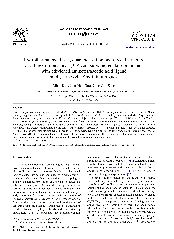摘要
A new supramolecular compound [Zn(H(2)EDTA)(H2O)](Q)(2)(H2O)(2) (1), where H(4)EDTA = ethylenediaminetetraacetic acid and Q = 4-(carboxylate)pyridinium, has been prepared by mild hydrothermal reaction and characterized by elemental analysis, IR spectrum and thermogravimetric analysis. Single-crystal X-ray diffraction of 1 [monoclinic, space group C2/c, a = 11.310(4) Angstrom, b = 9.704(4) Angstrom, c = 23.798(10) Angstrom, beta = 97.401(10)degrees, Z = 4] revealed that the Zn-II ion coordinates to the chelating tetradentate ligand H(2)EDTA and a water molecule, taking a distorted trigonal-bipyramid geometry. The mononuclear [Zn(H(2)EDTA)(H2O)] subunits are linked to form two-dimensional layered architectures by the lattice water moieties through O-(HO)-O-... hydrogen bonds, which are further extended to a three-dimensional (3D) supramolecular network by 4-(carboxylate)pyridinium guests (resulting from the ring-opening hydrolysis of 2,5-bis(4-pyridyl)-1,3,4-oxadiazole) through extensive hydrogen-bonding interactions. The 3D supramolecular framework is also stabilized by significant face-to-face pi-pi stacking interactions between the aromatic pyridinium systems.
- 出版日期2004-9-1
- 单位天津师范大学
